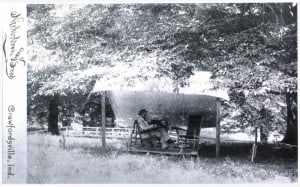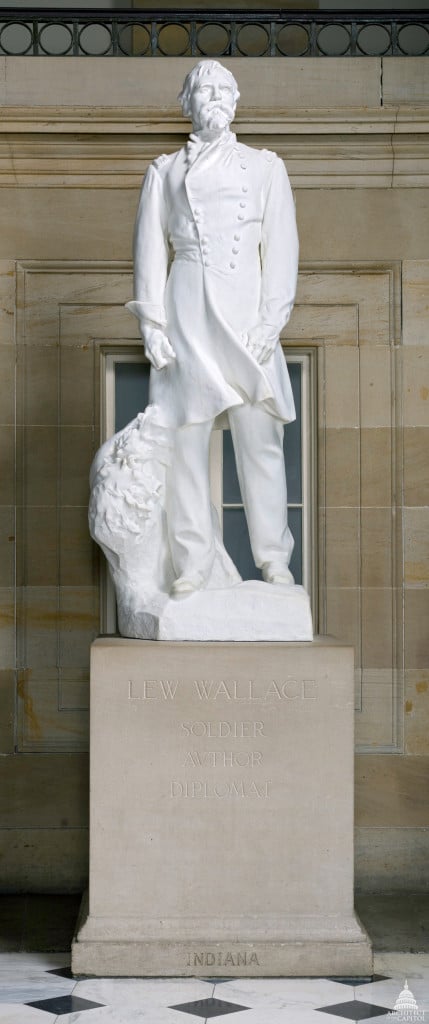Wallace enjoyed sitting and writing under his favorite tree, later named the Ben-Hur Beech. The 40-foot-tall beech was cut down in 1908 after being damaged in a storm. However, in 1910 a statue honoring General Lew Wallace was erected where the tree once stood.
Andrew O’Connor, a noted early twentieth century sculptor, cast the statue in bronze. He created it as a replica of the white marble statue of Lew that stands in Statuary Hall in Washington, D.C.
The Ben-Hur Beech Tree

Lew Wallace’s statue stands on the spot where the Ben-Hur Beech grew in the General’s lifetime. It was under this tree he wrote the bulk of Ben-Hur. Photographs show Lew sitting in his rocking chair with his lap desk, pen and paper at the ready. To set the proper mood for his creative muse, Lew perched his rocking chair and side table on a wooden platform draped in oriental rugs under the leafy cathedral.
In an article entitled “How Ben-Hur Was Written,” Lew says of his tree, “How often, when its thick branches have protected me with their cooling shadows, has it been the only witness to my mental struggles, and how often, too, has it maintained a quiet dignity, when it might have laughed at my discomfort. The soft twittering of birds, the hum of bees, the lowing of the kine, all made the spot dear to me.”
Another famous Hoosier author, nature-lover Gene Stratton-Porter, once visited the Study. She wrote about Lew’s magnificent trees–especially the Beeches “…which grew for the General in the most elaborate manner, truly lordly Beeches with wide-spreading arms of gray moleskin, great velvet trunks and branches almost sweeping the ground.”
Decline of the Ben-Hur Beech
By the late 19th century, the tree had been damaged by storms and was in decline. In an effort to save the tree, W.D. Malcomb of Lafayette worked for three consecutive years. Mr. Malcomb was a “specialist in forestry work.”
During his third year, Malcomb and his assistants chiseled out all the decayed portions of the tree and filled the cavity with cement. Then they tacked a zinc plate over the cement cap. Malcomb spent two weeks on the work. While this might have been state of the art tree surgery in 1900, modern arborists would never follow such a plan and this work probably accelerated the death of the tree.
Removal of the Ben-Hur Beech
The Ben-Hur Beech was cut down in 1908. As word spread, a large crowd gathered to watch the famous tree being reduced to firewood. People gathered pieces of the tree and took them home as valued souvenirs. Craftsmen fashioned portions of the tree into gavels. Several area newspapers published the tree’s obituary.
Beyond the gavels and other mementos of the Ben-Hur Beech, its importance to the Wallace family was demonstrated by Lew and Susan’s son, Henry. In 1910, he commissioned and erected the statue on a large stone base. Although it could have been placed anywhere on the grounds, Henry commemorated this beloved Beech tree and the role it played in father’s life.
Statue of Lew Wallace by Andrew O’Connor

The largest example of sculpture at the Study is the life size, free-standing statue of Lew Wallace created by Andrew O’Connor.
Every state selects two famous citizens to be represented in Statuary Hall in the U.S. Capitol. Statuary Hall is a large two-story semicircular room located in the Old Hall of the House just south of the Rotunda. From 1807 to 1857 it served as the U.S. House of Representatives.
The first statue came to the hall in 1870. Shortly after the turn of the twentieth century, Indiana chose Civil War Governor Oliver P. Morton and Major General Lew Wallace to represent the Hoosier State.
In 1907, a commission, composed of men from Washington and Indianapolis, began the selection process for the artist who would immortalize Wallace. After surveying the existing statues, they claimed the Wallace statue would be superior to any in Statuary Hall. Initial plans called for the statue to be made of bronze.
Andrew O’Connor
Andrew O’Connor sculpted the statue. O’Connor was an Irish-American sculptor who was born in 1874 in Worchester, Massachusetts, to Irish parents and died in 1941. He began his career as a boy working with his father, who carved grave markers for a living. His father was a quiet, hard-working man who by the end of his life had achieved recognition for his talent as a stone carver and sculptor. Andrew Jr. had talent combined with a drive that led him to many of the great cities of the world. As a result, he gained fame and introductions to some of the most influential people of his time.
In the early 1890s, O’Connor might have worked for the sculptor William Ordway Partridge at the Chicago World’s Fair. He also worked with the sculptor Daniel Chester French, the man who created the statue of Abraham Lincoln in Washington’s Lincoln Memorial.
For several years O’Connor used a studio in Paris. Then he returned to the United States and, ultimately, settled in Ireland. He exhibited for the first time in 1900. Within five years he had a number of important commissions. In America, O’Connor’s most famous works include an equestrian statue of Lafayette in Baltimore; the Theodore Roosevelt memorial at Glen View, Chicago; and a statue of Lincoln in Springfield, Illinois.
When O’Connor was selected by the Wallace Commission, he was widely recognized as one of the great artists of his time. Although the commission initially planned on a statue cast in bronze, O’Connor chose white marble for the statue. As it was being created, there was also interest in a second statue of Wallace for a prominent location in Indianapolis. Ultimately, however, the statue commissioned by Henry Lane Wallace ended up here outside his father’s Study.
Statue Dedication
Members of the Wallace Commission hosted a dedication ceremony on January 11, 1910. In addition Wallace family members, others present at the dedication included James Whitcomb Riley, Senator Albert J. Beveridge, Governor Thomas Marshall of Indiana, and a host of Hoosier and Washington dignitaries. Riley shared a poem created in remembrance of his friend Wallace. The poem opened with the lines:
Even as his sculptured counterpart
Shall endure through dateless time,
So lives he still, in soul and heart,
Heroic and sublime.
You can read the full text of the poem and learn more about Riley and Wallace’s friendship on our blog.
The white marble statue of Wallace continues to stand proudly in the heart of Statuary Hall. For more information, visit the Architect of the Capitol pages about Statuary Hall and about Lew Wallace.